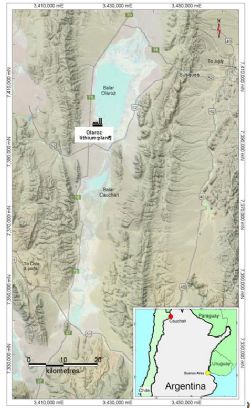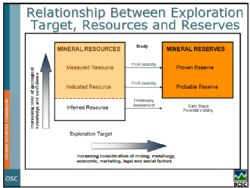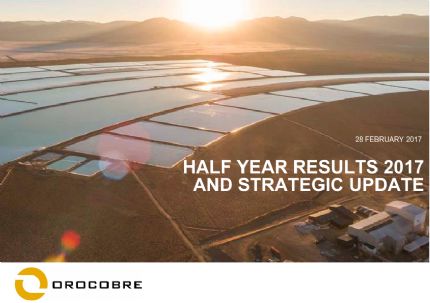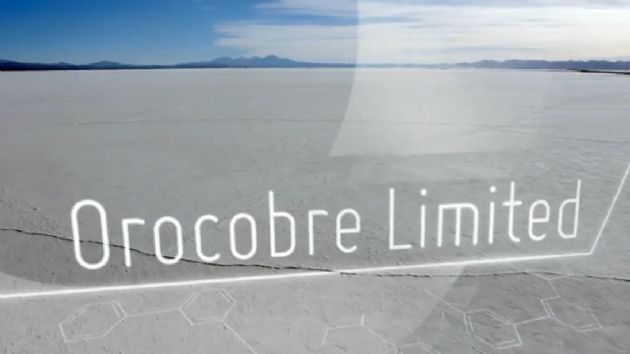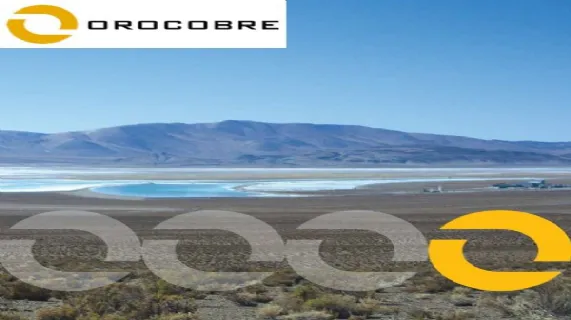
Cauchari Exploration Target Revision
Brisbane, Nov 24, 2016 AEST (ABN Newswire) - In conjunction with announcement of the joint venture (JV) between Orocobre Limited ( ASX:ORE) (
ASX:ORE) ( TSE:ORL) (the Company or Orocobre) and Advantage Lithium Corp. (
TSE:ORL) (the Company or Orocobre) and Advantage Lithium Corp. ( CVE:AAL) (Advantage Lithium) on the Cauchari project ("Cauchari") in Jujuy Province, North West Argentina the company provides the following technical details.
CVE:AAL) (Advantage Lithium) on the Cauchari project ("Cauchari") in Jujuy Province, North West Argentina the company provides the following technical details.
Highlights
- The Cauchari project lies between Orocobre's producing Olaroz Lithium facility and the pre-development Cauchari project of Lithium Americas Corp and SQM
- The Cauchari project currently contains an inferred resource of approximately 470,000 tonnes lithium carbonate equivalent and 1.6 million tonnes of potash (Table 1 in link below)
- A revised exploration target of between 5.6 million tonnes and 0.25 million tonnes of lithium carbonate equivalent and 19 million tonnes to 0.9 million tonnes of potash (KCl) has been estimated beneath the resource to 350 metres deep in the eastern properties and to 450 metres deep in the western properties (Table 2 in link below). It must be stressed that an exploration target is not a mineral resource. The potential quantity and grade of the exploration target is conceptual in nature, and there has been insufficient exploration to define a Mineral Resource in the volume where the Exploration Target is outlined. It is uncertain if further exploration drilling will result in the determination of a Mineral Resource in this volume.
- Brine chemistry (Mg/Li ratio 2.8) is similar to that at Olaroz and initial evaluation of the process suggests the brine could be processed by a similar process route to Olaroz
As announced on October 22, 2012, the project currently contains an inferred resource in two adjoining areas of the salar, with a total 230 million cubic metres of brine at average grades of 380 mg/L lithium and 3700 mg/L potassium. This is equivalent to 470,000 tonnes of lithium carbonate and 1.6 million tonnes of potash (potassium chloride) based on 5.32 tonnes of lithium carbonate being equivalent to one tonne of lithium and 1.91 tonnes of potash being equivalent to one tonne of potassium. Details are given in the following table.
As per Canadian reporting requirements Advantage Lithium will release an NI 43-101 resource report within 45 days of this announcement related to the Cauchari transaction.
Due to differences in drill hole depths the resource was divided into a northern and a southern resource area. The resource was estimated using a conservative approach limited by the depth of drilling, with the estimate extending to 170 metres depth in the northern area of the properties and 50 metres depth in the southern area.
The resource boundaries are constrained by the company's property holdings, drilling results and geophysical survey interpretation. No internal cut-off boundaries have been used because both the Company and Competent Person/Qualified person consider it is inappropriate to apply them in a fluid resource where extraction will cause mixing. No external cut off was defined for the resource, due to the limited drilling and pit sampling completed on the project to date. The property boundaries were used as the western, northern and southern boundaries to the brine resource. Hole CAU006R was excluded from the resource due to a different drilling and sampling methodology and sub 100 mg/l Li composite sample results.
The brine body has attractive chemistry, with a low magnesium to lithium ratio (2.8) in the five diamond holes and a high potassium to lithium ratio (10). The sulphate to lithium ratio averages 61 in diamond holes CAU001D-4D, rising to 114 in hole CAU005D in the eastern part of the resource area. Initial evaluation of the brine chemistry suggests high recoveries of lithium could be expected using a process route similar to that at the adjacent Olaroz project.
Introduction
The Cauchari Project is located immediately south of the Company's Olaroz lithium-potassium project (Figure 1 in link below), within the Province of Jujuy, Argentina. From October to December 2011 the company drilled five diamond and one rotary vertical drill holes in the Cauchari properties, followed by chemical analyses of the brine and porosity testing. This work provided the basis of the maiden resource estimate in 2012, by independent consulting hydrogeologist Murray Brooker, and other conclusions presented in this announcement.
Orocobre activities have concentrated on exploration and development planning at the Olaroz salar project since 2008 with the project now in the final stages of production ramp up. The Olaroz lithium facility has a design capacity 17,500 tonnes per annum of lithium carbonate production and the company has recently completed a scoping study into options for expansion of the project. Joint venture of the Cauchari project allows the company to concentrate on optimised operations and expansion at Olaroz.
Geology, Data and Interpretation
The company collected Audiomagnetotelluric (AMT) and gravity geophysical measurements in the salar prior to drilling in 2011. The Cauchari North geophysical line (in the resource area) suggests the eastern JV properties contain in excess of 350-400 metres of salar sediments, providing an attractive target for future drilling. Drilling on adjacent properties within the Cauchari salar by Lithium Americas Corp ( TSE:LAC) has intersected brine bearing salar sediments to 450 metres (DDH7) and recent drilling to the north in Olaroz, by Orocobre, has also intersected brine bearing sediments to a depth of 450 metres with geophysical surveys indicating a potentially greater basin depth. No drilling has intersected basement.
TSE:LAC) has intersected brine bearing salar sediments to 450 metres (DDH7) and recent drilling to the north in Olaroz, by Orocobre, has also intersected brine bearing sediments to a depth of 450 metres with geophysical surveys indicating a potentially greater basin depth. No drilling has intersected basement.
In late 2011 Orocobre drilled a total of six drill holes (five diamond and one rotary) in the Cauchari salar with the deepest hole CAU001D (in the north of the properties) drilled to 249 metres. Holes were drilled with an average spacing of 3.3 kilometres. Drilling intersected from surface a sequence of silt and clay up to 60 metres thick, overlying a sequence of halite, interbedded with intervals of clastic sediment to the base of drilling. Down-hole geophysical logging data was collected to assist with correlation between holes. All holes were geologically logged in detail by an experienced geologist and photographs of the core taken. Details of the exploration undertaken in the drilling program were provided by Orocobre in the ASX/TSX announcement dated 22 October 2012.
The western Cauchari properties are adjacent to where Lithium Americas Corp interprets brine to continue beneath the Archibarca alluvial fan. Geophysics carried out by Lithium Americas Corp (NI43-101 report, July 12, 2012) suggests that brine continues beneath a near surface fresh water zone and a mixed zone on both the western and eastern margins of the salar. No exploration drilling has yet been carried out in the JV western Cauchari properties and this is a priority area for future work.
Resource Estimation
The 31.04 km2 areal extent of the maiden 2012 Cauchari resource was controlled by the location of the property boundaries, drilling results, geophysical profiles and salar geomorphology. The resource estimate is based on geological controls from the six holes drilled, with rotary drill hole CAU006R lying outside the resource area. Brine composite samples were taken with a bailer at a vertical spacing of 1.5, 3 and 6 metres during the diamond drilling. The location of the holes was controlled by access to the salar, with embankments constructed to reach sites and drill before the commencement of the wet season in early January. Drill holes were located with a hand held GPS.
Mean Sy (Drainable Porosity) values from the porosity analyses were used to calculate a weighted Sy value for each drill hole, based on the lithologies and thicknesses recorded during logging. A continuous Sy value was also calculated for each hole, where geophysical logging (neutron logs) was available. Continuous Sy values were calculated using an algorithm relating neutron porosities (recorded every centimetre down hole during geophysical logging) and Pt values; using a modification of the methodology outlined by Houston and Gunn (2011). The results of the lithology-weighted and the continuous Sy values were then averaged to obtain a Sy value for each hole, as input to the resource estimate.
The averaged Sy data for each hole was used to calculate an equivalent brine thickness at the location of each diamond hole over a m2 unit area (length of interval in hole [i.e. 170 metres] by Sy value = equivalent brine thickness for each hole as m/m2).
The mass of lithium (Li), potassium (K) and boron (B) for the square metre centred on each diamond hole was calculated by multiplying the equivalent brine thickness (converted to a volume in litres) by the kg/l concentration of each element of interest in the diamond hole. This mass data from the diamond holes was then kriged across Orocobre's Cauchari tenements to produce concentration maps of kg/m2 for Li, K and B. The sum of the individual grid cells provides the total resource mass as presented in Table 1 in link below this announcement.
Future Drilling by the Joint Venture
Only one of the holes in the 2011 drilling program, upon which the resource estimate is based, reached the then target depth of 250 metres. Based on a likely depth of the Cauchari basin to be 350-450 metres plus, there is considerable potential to add to the existing resource. Consequently, the company believes further drilling would significantly expand the size of the Cauchari resource.
A revised exploration target has been estimated to quantify the potential in addition to that beneath the resource announced in 22 October 2012. This addition to the exploration target is in the western properties of the Cauchari project. This western target represents the extension of the deeper aquifer units present at Olaroz, immediately north of the joint venture western properties, which are likely to extend beneath the Archibarca alluvial fan into these western properties.
Exploration Target
Based on available geophysics, geology and geochemistry it is possible to define an exploration target beneath the resource and in the western properties, outlined in Table 2 of this announcement. The relationship of an exploration target to the CIM and JORC resource definitions is shown in Figure 2 in link below.
It must be stressed that an exploration target is not a mineral resource. The potential quantity and grade of the exploration target is conceptual in nature, and there has been insufficient exploration to define a Mineral Resource in the volume where the Exploration Target is outlined. It is uncertain if further exploration drilling will result in the determination of a Mineral Resource in this volume.
The exploration target is where, based on the available geological evidence, there is the possibility of defining a mineral resource. In keeping with Clause 18 of the JORC Code and CIM requirements the exploration target defined at Cauchari is:
- Not to be considered a resource or reserve,
- Based on information summarized in link below.
It is a requirement of stating an exploration target that it is based on a range of values, which represent the potential geological conditions. Values have been selected to present an Upper and a Lower exploration target size. It is likely that the lithium and potassium contained in the exploration target lies somewhere between this Upper and Lower Case.
Information Used to Define the Exploration Target
Orocobre's 2011 drilling intersected grades of >400 mg/l Li at or near the base of holes CAU001D (249 metres), CAU002D (186 metres) and CAU005D (168 metres). Accordingly, elevated Li grades may continue beneath the depth of the Cauchari northern and southern resource areas (170 metres and 50 metres respectively) and beneath the depth of CAU001D.
Orocobre previously conducted a geophysical survey in the Cauchari Resource area (Cauchari North line) in which gravity and Audiomagnetotelluric (AMT) data was collected. The AMT data (Figure 3) suggests brine is present in salar sediments beneath the Orocobre properties to depths of ~350 metres or more, with a coincident gravity survey suggesting depths of 300-450 metres or more to the salar basement.
Additional information is available from the work, including drilling and geophysics, undertaken by Lithium Americas Corp on adjacent properties. This information, which principally relates to the area immediately west of the Cauchari 2012 resource, suggests salar sediments were intersected to 449.5 metres (end of hole) below surface (hole DDH7 in Appendix 1 of King, 2010), with multiple other holes intersecting salar sediments to 350 metres deep. This suggests that beneath the western properties south of the Olaroz project a similar thickness of sediments is present, potentially with economic lithium brine concentrations.
Consequently, there is reason to believe the lithium-bearing brine in the Orocobre properties extends to 350-450 metres or deeper. The deeper drilling conducted by Lithium Americas Corp (Figure 7-7, feasibility study July 11, 2012) suggests there is a thick layer of sand underlying the halite sequence intersected in Orocobre drilling. This deep sand unit suggests potential for the same unit in the Cauchari project, beneath the depth of current drilling. Similarly, in the Orocobre Olaroz project to the north drilling has intersected sand units at this depth.
Estimation of the Exploration Target
The following parameters have been used to estimate an Upper Assumption and Lower Assumption case for lithium and potassium in the Cauchari Exploration Target. The former uses the higher values for all parameters and the latter uses the lower values. Values used are shown in Table 2 in link below.
The thickness of the resource (Table 1) depends on the drilling depths of Orocobre holes and has been separated into a northern and southern area reflecting this. The eastern part of the exploration target (defined to lie immediately below the resource) is consequently also separated into a northern and southern target under the same surface outlines.
Area
- The Northern target covers 19.69 km2;
- The southern target 11.35 km2;
- The northwestern target of 22 km2
- A small southwestern target of 2.4 km2
The total area (eastern and western areas and subareas) is 55.44 km2.
Thickness
A variable thickness is used for the target estimate, depending on the thickness of the overlying resource area and the potential thickness of gravels without Li-mineralised brine in the western area, based on information from nearby drilling in adjacent properties.
Eastern tenements
- In the northern area, a thickness of 180 metres (from 170 to 350 metres depth) as the Upper Assumption and the Lower Assumption; and
- In the southern area, a thickness of 300 metres (from 50-350 metres depth) as the Upper Assumption and 170 metres (from 50 to 220 metres ) as the Lower Assumption, to account for the possibility of basement closer to surface or a thinner brine column.
Western tenements
- In the northwestern area, a thickness of 300 metres (from 150 to 450 metres depth) is the Upper Assumption reducing to 150 metres in the Lower Assumption; and
- In the southwestern area, a thickness of 300 metres (from 50 to 350 metres depth) is the Upper Assumption and 200 metres (from 50 to 250 metres) as the Lower Assumption, to account for the possibility of basement closer to surface or a thinner brine column.
Porosity
Porosity is a vital measurement in determining a brine resource and it is important to understand the difference between definitions of porosity. Only part of the total porosity (Pt) consists of interconnected pores that can be drained. The drainable porosity component is referred to as the specific yield (Sy) - the proportion of water that can be yielded when the aquifer is pumped.
The BGS Sy measurements at Cauchari and Olaroz have been used for the porosity values in the exploration target estimate.
- For the Upper Assumption 13% is used as the specific yield (equivalent to the sand dominant Sy at Olaroz or a mixture of porous halite [16% at Cauchari] and some finer grained sediments)
- For the Lower Assumption 2% is used as the specific yield (equivalent to compact halite at Cauchari)
Lithium and Potassium Concentrations
- A value of 537 mg/L for Li and 5350 mg/l K is used in the upside case for the eastern tenements, (equivalent to the average of chemistry data sets from CAU001D bailer and core extraction samples). This compares to values of 600 mg/l and 570 mg/l Li used for the updated Lithium Americas Corp resource (outlined in the 12 July 2012 Feasibility study). The corresponding K values determined by Lithium Americas Corp were 5156 and 4753 mg/l,
- A value of 260 mg/L Li and 2550 mg/L K is used in the Lower Assumption case (representing the lower grade values from the southern shallow part of the Orocobre Cauchari resource - see Table 1).
The contained lithium in the exploration target (combining values for the eastern and western areas - see Table 2) ranges from the Upper Assumption case of 5.6 million tonnes of lithium carbonate and 19 million tonnes of potash to the Lower Assumption case of 0.25 million tonnes of lithium carbonate and 0.9 million tonnes of potash. The concentrations in the Lower Assumption case are not economic brine grades at current market conditions. Note the total exploration target is different to that announced by Orocobre on 22 October 2012, as the exploration target in the western properties has been added, taking into consideration exploration results at the Company's Olaroz lithium project and the LAC Cauchari project.
It must be stressed the exploration target is based on a series of assumptions and future drilling is required to determine the brine grade and formation porosity (Sy) values to establish whether a resource can be defined.
Data Collection and QA/QC
Obtaining high quality samples in the field and ensuring that subsequent analysis of the samples was carried out to a high standard was considered of great importance, bearing in mind the technical challenges of sampling fluids (brines) and semi-consolidated sediments.
Orocobre's initial diamond drilling program in the Cauchari salar was conducted using lexan tubes in the place of the triple tube splits, to maximize core recovery and geological understanding. Notwithstanding the best efforts of geologists and contractors, core recoveries averaged 76%. Down-hole geophysical logging was undertaken on diamond drill holes to provide additional geological information. Fluorescein (biodegradable) dye was used in the drilling fluid, to indicate whether brine samples taken with a bailer during the drilling were contaminated with drilling fluid.
As a further check on the results of brine samples obtained by bailing, during diamond drilling, brine was also extracted from core samples in a British Geological Survey (BGS) laboratory in the UK, where this brine was also analysed. Differences are noted between the two chemical data sets, although the contained metal and average grade of the estimated resource was similar for each data set. Data obtained by bailing, (obtaining a brine sample from a steel tube with a valve at the base, lowered into the drill hole on a cable) during drilling of diamond holes, was used for the resource estimate and as the basis for definition of the exploration target.
Core samples from diamond drill holes were used for measurements of total porosity (total contained fluid) and specific yield (recoverable fluid), with measurements made at the British Geological Survey laboratories using recognized techniques.
Chemical analyses on bailed samples were undertaken by Alex Stewart Assayers (Argentina) S.A. ("ASA") in Mendoza, Argentina. This laboratory has extensive experience analyzing brines from salar projects. They are ISO 9001:2000 accredited and operate their own internal standards consistent with ISO 17025.
Standards and duplicate samples were used extensively, with laboratory-prepared and field standard samples submitted to the laboratory comprising 16% of the samples submitted and duplicates comprising a further 7% of the total samples.
With minor exceptions, analytical values of the standards fell within +/-10% of the standard values for samples in the diamond drilling. Duplicate samples showed a high level of sample repeatability (precision), with all but five sample pairs falling well within +/-10% limits. Ion balances confirm the general quality of the ASA analyses. Additionally, 15 duplicate samples were analysed at the University of Antofagasta to compare with the ASA sample values. These sample pairs show average reproducible percentage differences of 5.6% for lithium and 16.6% for potassium. Overall the analyses are considered to be of acceptable quality for the inferred resource estimate, based on the results of the QA/QC samples.
The resource estimate summarized in this announcement has been prepared by independent hydrogeologist Murray Brooker, addressing the standards set out in the Canadian Securities Administrators' National Instrument 43-101.
To view tables and figures, please visit:
http://abnnewswire.net/lnk/O5HNCW54
About Orocobre Limited
 Orocobre Limited is listed on the Australian Securities Exchange and Toronto Stock Exchange (
Orocobre Limited is listed on the Australian Securities Exchange and Toronto Stock Exchange ( ASX:ORE) (
ASX:ORE) ( TSE:ORL) (OTCMKTS:OROCF), and is building a substantial Argentine based industrial chemicals company through its portfolio of lithium, potash and boron assets. In partnership with Toyota Tsusho Corporation (TTC) and JEMSE, Orocobre has built and is now operating the world's first commercial, brine-based lithium operation constructed in approximately 20 years.
TSE:ORL) (OTCMKTS:OROCF), and is building a substantial Argentine based industrial chemicals company through its portfolio of lithium, potash and boron assets. In partnership with Toyota Tsusho Corporation (TTC) and JEMSE, Orocobre has built and is now operating the world's first commercial, brine-based lithium operation constructed in approximately 20 years.
In 2018 Orocobre announced the Stage 2 Expansion of its flagship Olaroz Lithium Facility in Argentina. The Stage 2 Expansion will add 25,000 tpa of lithium carbonate production capacity, taking full production and capacity to 42,500 tpa of lithium carbonate for sale to industrial, technical and battery markets, positioning Orocobre as one of the world's largest and lowest cost lithium chemicals producers.
Additionally, Orocobre and Toyota Tsusho Corporation have commenced construction of the 10,000 tpa lithium hydroxide plant in Naraha, Japan. The construction of the Naraha Lithium Hydroxide Plant will further cement Orocobre's position as a global lithium chemicals producer operating at the bottom quartile of the lithium cost curve. This new hydroxide plant will be the first of its kind in Japan and will provide Orocobre product diversification suitable for different battery technologies and the potential for significant margin growth on our primary lithium carbonate being converted to battery grade lithium hydroxide.
| ||
|



